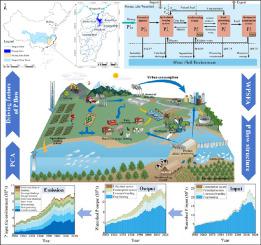Water Research ( IF 11.4 ) Pub Date : 2023-08-30 , DOI: 10.1016/j.watres.2023.120546 Wei Liu 1 , Tian Qin 1 , Mengting Wu 1 , Zhiqin Chen 1 , Yalan Zhang 1 , Evgeny Abakumov 2 , Ekaterina Chebykina 2 , Wenjuan Wang 2 , Daishe Wu 3 , Chao Han 4 , Xianchuan Xie 1 , Jiancheng Cheng 1 , Xinlong Hua 1 , Sunlin Chi 1 , Jinying Xu 1

|
Understanding the historical patterns of phosphorus (P) cycling is essential for sustainable P management and eutrophication mitigation in watersheds. Currently, there is a lack of long-term watershed-scale models that analyze the flow of P substances and quantify the socioeconomic patterns of P flow. This study adopted a watershed perspective and incorporated crucial economic and social subsystems related to P production, consumption, and emissions throughout the entire life cycle. Based on this approach, a bottom-up watershed P flow analysis model was developed to quantify the P cycle for the first time in the Poyang Lake watershed from 1950 to 2020 and to explore the driving factors that influence its strength by analyzing multi-year P flow results. In general, the P cycle in the Poyang Lake watershed was no longer a naturally dominated cycle but significantly influenced by human activities during the flow dynamics between 1950 and 2015. Agricultural intensification and expansion of large-scale livestock farming continue to enhance the P flow in the study area. Fertilizer P inputs from cultivation account for approximately 60% of the total inputs to farming systems, but phosphate fertilizer utilization continues to decline. Feed P inputs have continued to increase since 2007. The expansion of large-scale farming and the demand for urbanization are the main factors leading to changes in feed P input patterns. The P utilization rate for livestock farming (PUEa) is progressively higher than international levels, with PUEa increasing from 0.64% (1950) to 9.7% (2020). Additionally, per capita food P consumption in the watershed increased from 0.67 kg to 0.80 kg between 1950 and 2020. The anthropogenic P emissions have increased from 1.67 × 104 t (1950) to 8.73 × 104 t (2020), with an average annual growth rate of 2.41%. Watershed-wide P pollution emissions have increased by more than five-fold. Population growth and agricultural development are important drivers of structural changes in P flows in the study area, and they induce changes in social conditions, including agricultural production, dietary structure, and consumption levels, further dominating the cyclic patterns of P use, discharge, and recycling. This study provides a broader and applicable P flow model to measure the characteristics of the P cycle throughout the watershed social system as well as provides methodological support and policy insights for large lakes in rapidly developing areas or countries to easily present P flow structures and sustainably manage P resources.
中文翻译:

自下而上流域尺度磷物质流模型分析1950—2020年我国最大淡水湖(鄱阳湖)流域磷流特征
了解磷 (P) 循环的历史模式对于流域的可持续磷管理和富营养化缓解至关重要。目前,缺乏分析磷物质流动和量化磷流动社会经济模式的长期流域尺度模型。这项研究采用了分水岭的视角,纳入了整个生命周期中与磷生产、消费和排放相关的关键经济和社会子系统。基于该方法,建立了自下而上的流域磷流分析模型,首次量化了鄱阳湖流域1950—2020年的磷循环,并通过分析多年磷的强度,探讨了影响其强度的驱动因素。流量结果。总体而言,1950年至2015年间,鄱阳湖流域的磷循环不再是自然主导的循环,而是受到人类活动的显着影响。农业集约化和规模化畜牧业的扩张不断增强了鄱阳湖流域的磷流量。研究区。耕作过程中磷肥投入约占耕作系统总投入的 60%,但磷肥利用率持续下降。2007年以来饲料磷投入持续增加,规模化养殖规模扩张和城镇化需求是导致饲料磷投入格局变化的主要因素。畜牧业磷利用率(PUEa)逐步高于国际水平,PUEa从1950年的0.64%提高到2020年的9.7%。此外,流域人均粮食磷消费量从1950年的0.67千克增加到2020年的0.80千克。人为磷排放量从1.67×10 4 t(1950年)增加到8.73×10 4 t(2020年),平均年增长率为2.41%。全流域磷污染排放量增加了五倍多。人口增长和农业发展是研究区磷流动结构变化的重要驱动因素,引起农业生产、膳食结构和消费水平等社会条件的变化,进一步主导磷利用、排放和利用的循环模式。回收。本研究提供了更广泛、适用的磷流模型来衡量整个流域社会系统的磷循环特征,并为快速发展地区或国家的大型湖泊轻松呈现磷流结构和可持续管理提供方法论支持和政策见解。 P资源。






























 京公网安备 11010802027423号
京公网安备 11010802027423号